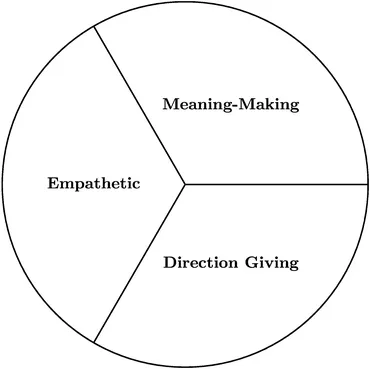This book reaches out to everyone who wants to know more about effective and ethical leader spoken communication. Why does such language matter, what is it, what’s the best way to use it, and how does it affect others? We will respond to these questions and others with a journey through motivating language (ML) . Motivating language is a compass that seeks to align follower aspirations with organizational vision using leader talk. Simply put, ML helps leaders to better connect with their followers and improves follower and firm well-being. To help you understand how ML fulfills this mission, our introduction gives an overview about why ML matters, what it means, and its influence on organizations and their employees. The introduction also lays out this book’s architecture.
Too often communication is implicit in leadership behavior, an elephant in the room. That is to say that effective leader communication is assumed to be important, but its definition is hard to grasp, and its application is not strongly emphasized. Effective leader communication ushers in positive results for the organization and its stakeholders, including employees. Researchers, managers, aspiring leaders, students, and other observers have long wondered about what successful leader communication entails, especially spoken words.
Talk is a vital part of what most leaders do (We adopt Neck and colleagues’ definition of leadership as “a process of influence for directing behavior toward accomplishing goals” (Neck et al. 2016, p. 4)). A leader’s work is often accomplished through talk, accounting for up to 80% of their time (Mintzberg 1973; Van Quaquebeke and Felps in press; Wajcman and Rose 2011). Plus, most of this oral communication happens with followers (Tengblad 2006; Van Quaquebeke and Felps in press).
When speaking with subordinates, language bridges leader intent and purpose. In fact, leader talk transmits signals which can arouse follower motivation—“observable changes in the initiation, direction, intensity and persistence of voluntary action” (Kanfer et al. 2017, p. 339). Simply put, motivation is our drive to contribute. All humans possess this need, and it can be enhanced or diminished through communicative exchanges, especially those which entail a more powerful other, including the words that a leader says to a follower (Van Quaquebeke and Felps, in press). Motivation, the resulting psychological state, is translated by followers in their attitudes toward work, their relationships with leaders, their capabilities and initiatives, and in their job performance .
Yet despite this important role, guidelines for how effective leader communication works are often fuzzy, general rules of thumb, even glib. We were inspired to clarify these ambiguous rules by our own private sector organizational experiences. In these settings, we were often puzzled by just what leader talk was trying to accomplish, or worse yet, by its absence when sorely needed. To our knowledge, there are few evidence-based road maps for leaders who want to speak mindfully in order to advance the best interests of followers and the organization. Motivating language helps to fill this gap by giving a systematic, research-tested model that covers all forms of leader-to-follower speech.
So where does motivating language come from and how is it defined? Much of this question will be answered in this book’s first four chapters, but here is a brief summary. Motivating language was originally called motivational language by its founder, Dr. Jeremiah Sullivan (1988). This scholar recognized that leaders ’ spoken messages could spark employee motivational states. Drawing on this insight, Sullivan asserted that most managers fail to use the full range of language or do not use it strategically. These missteps limit the motivational potential of their talk. For guidance on how to address this shortcoming, he turned to linguistics theory and reinterpreted it for organizational contexts. Sullivan’s conversion was also firmly rooted in management and social sciences theory and can be captured in three types of leader talk: direction-giving , meaning-making , and empathetic language .
Here is a brief sketch of each ML facet, all of which will be much more detailed in the remainder of this book.
Direction-giving language emphasizes the steps to attain the organizational vision, goal setting, giving clear task parameters, informational transparency, and articulating
reward contingencies. This form of talk dominates in most organizations. Next,
meaning-making language explains organizational vision and culture, often informally and by using stories or metaphors. This form type of speech also lets a follower know that her or his work is valuable and how it contributes to a bigger picture.
Meaning-making language informs the follower about how personal goals can be integrated into purposeful work. The last ML facet,
empathetic language , is least commonly expressed and sends messages of genuine caring for a follower’s well-being. These oral messages include civility, empathy, compassion, and positive emotional support for a follower. Figure
1.1 gives a diagram of all three ML facets, also referred to as ML dimensions in this book.
Researchers have made much progress since the initial model’s introduction. ML now has a robust and valid scale, the motivating language scale (MLS) , that draws on follower perceptions. Compelling studies using the MLS and other qualitative methods suggest that ML has significant and positive links with many important workplace outcomes including—but not limited—to employee engagement, job satisfaction , self-efficacy , performance , creativity , innovation , perceived leader competence, intention to stay, voice , lower absenteeism , and effective decision making . While most of these studies are cross-sectional, correlational, and have dyadic or individual levels of analyses...


